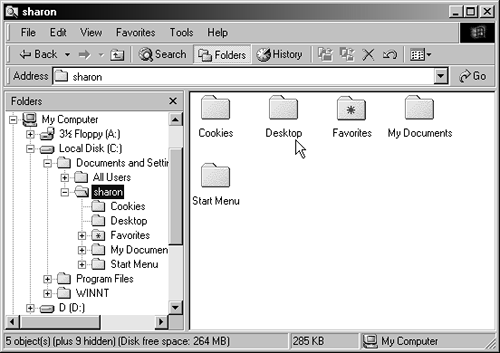The first time you turn on a PC after installing Windows 2000 (or after un-packing a new PC that has Windows 2000 preinstalled), you encounter a Getting Started wizard that offers three choices:
Register Now. Register your copy of Windows 2000 with Microsoft, so that you're eligible for exciting new streams of junk mail.
Discover Windows. Take a quick tour of Windows 2000 features (you'll be asked to insert your installation CD).
Connect to the Internet. Sign up for an Internet account using the Internet Connection Wizard (see Section 11.1.3).
Once you're beyond this big hello, however, you encounter the digital vista shown in Figure 3-1, a screen that greets tens of millions of people every morning: the Windows desktop.
Figure 3-1. Everything you'll ever do on a Windows 2000 Pro computer begins with a click on one of these three elements: a desktop icon, the Start button, or the Taskbar, which is described in Chapter 4. Some people find this default desktop too cluttered already, and promptly delete some of the icons they'll never use. Others place even more icons on the desktop—favorite programs and documents—for quicker access. Let your personality be your guide.
The desktop is the backdrop for all activities in Windows 2000. The desktop is a virtual desk that holds virtual folders and files while you work; depending on your personality type, it can attract lots of junk.
The standard Windows 2000 Pro installation puts these icons on your desktop:
My Documents. The My Documents folder is a handy storage place for your letters, memos, and other work files. Most modern programs propose saving any new files you create into this folder.
On some networks, you may be required to place all your work in this folder, so that your files will be included when the network performs a system-wide backup. On other networks, you may be required to put you files anyplace except My Documents.
My Computer is the trunk lid, the doorway to every single shred of software on your machine. When you double-click My Computer, a window opens to reveal icons that represent each disk drive in your machine, as shown in Figure 3-2. (Note to power users: Technically, My Computer shows a different icon for each hard drive partition.)
Figure 3-2. This computer has one floppy drive, one hard drive, and one CD-ROM drive. For your convenience, you also get a link to the Control Panel folder (see Chapter 8). If you click an icon to select it, Windows politely shows you a description on the left side of the window. If there's a disk in the CD-ROM drive, you get to see its name, not just its drive letter.
By double-clicking, for example, your hard drive icon, and then the various folders on it, you can eventually see the icons for every single file and folder on your computer.
Note
The My Computer window shows you an icon for each disk drive in your machine—floppy drive, Zip drive, CD-ROM drive, and so on—whether or not there's actually a disk in that drive. If you try to double-click one of these icons when the corresponding drive is empty, you'll get nothing but a confusing error message. (It tells you that the drive "isn't ready," which isn't the problem at all.)
Internet Explorer opens the Internet browser that comes with Windows (see Chapter 11).
Recycle Bin. You delete a file or folder by dragging it onto this icon. You can read more about this special icon on Section 5.3.3.
My Network Places provides links to other machines on your network, as well as tools for making those links. For more on networking and using this icon, see Chapters 13, 14, and 15.
Outlook Express is an email program you can use to send and receive email and read the messages on Internet newsgroups (bulletin boards). See Chapter 12 for more on Outlook Express.
Connect to the Internet launches the Internet Connection Wizard described in Chapter 11.
Some people maintain that the desktop is best kept clean, and that all document files should be put away in their proper locations (such as the My Documents folder). Other people believe that every useful icon (or its shortcut—see Section 5.4.3.4) should be placed on the desktop for easy access. Needless to say, the second approach leads to a fair amount of clutter and can make finding things difficult—just like a messy desk. However, if things become too chaotic, you can always right-click a blank spot on the desktop (assuming you can find one) and choose Arrange Icons or Line Up Icons from the shortcut menu. Doing so doesn't make your desktop any less cluttered, but at least it nudges all of your desktop icons so that they all line up nicely.



